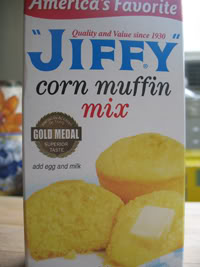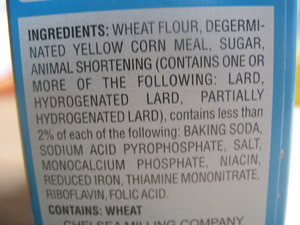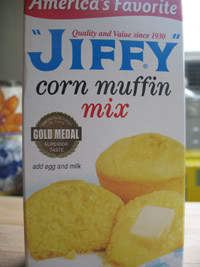This morning I taught my third session of Parents Need to Eat, TooSM. The topic: Big Batch Cooking—stuff that might take you a couple hours to prepare, but you’ll wind up with so much yumminess that you’ll get at least two meals out of it and more to freeze. Today we cooked Three-Bean Turkey Chili together, and talked about the particulars of freezing and reheating.
One of the basic tenets of Parents Need to Eat, TooSM, is that you don’t have to make everything from scratch. There are certain processed foods that are perfectly fine if it’s a question of dinner or no dinner. One of them, I thought, was corn bread mix. So when I did my big shop to buy all the ingredients for class (that’s a whole lot of ground turkey, beans, and tomatoes, folks), I tossed in a box of corn bread mix for each student. I figured we’d bake it off while the chili simmered.

(It’s Jiffy brand! America’s Favorite! Quality and Value Since 1930!)
One of my students is kosher—no biggie, I picked up special ingredients for her; since I grew up kosher I know what to watch for. Exceeeeept that I forgot to look at the corn bread packaging. As soon as S sat down and saw the box, she said she’d skip that part—the mix calls for milk, and the big kahuna of kashrut is milk + meat = no. Fair enough, though I was embarrassed not to have thought of it. Just for fun, I picked up the box and started reading, to see if maybe we could think of a workaround—soy milk or something. And then I saw it:

Freaking Jiffy brand corn bread mix has LARD in it. I’m thoroughly disgusted. And in case you’re thinking it’s just me, everyone in the room had the same reaction: In this day and age, how can it still have lard in it? Hasn’t everyone reformulated by now to remove the pig fat? Apparently not. Come on, Jiffy, even Oreos reformulated! They risked their cookie goodness, their world-wide status as America’s Cookie, to get rid of the pork. I can’t believe your corn muffins wouldn’t be the same without it. Especially since most corn bread recipes I’ve seen don’t even hint that lard is a key ingredient. Sigh.
Anyway, here are my tips for freezing and reheating:
• Cool your food before putting it in the freezer, and be careful not to leave anything at room temperature for more than 2 hours—at that point bacteria starts to grow. I generally leave things at room temp for 1/2 an hour to an hour, just to get them to the point where they’re not hot-hot, and refrigerate. Then I transfer to the freezer later. An extra step, I know, but it’s safer and will pay off in easy-to-reheat meals down the line.
• Exposure to air in the freezer leads to freezer burn, so you’ll want to make sure everything’s wrapped as tightly as possible. I like freezer-weight zipper bags—they take up the least space in your freezer. Squeeze out all the excess air, and if what you’re freezing is soupy or stewy, lay it on a cookie sheet in the freezer to help it hold a flat shape. Once it’s frozen solid you can remove the cookie sheet and stack the bags horizontally or vertically.
• If you’re freezing things that you’ll want to use individually (like meatballs or chocolate chip cookie dough), portion it out and put in a single layer on a wax paper-lined cookie sheet. Once they’re frozen, transfer to freezer bag.
• Don’t forget to label everything! I identify the item & put the date it was cooked/frozen, as well as simple reheating instructions. Most zipper bags have a designated labeling space—use a Sharpie.
• If you’re freezing a casserole, before baking line the dish with heavy-duty aluminum foil. After cooking/cooling, put the whole thing in the freezer. Once it’s frozen, remove the food from the dish, add another layer of foil or put it in a giant freezer bag, label, and store. To reheat, put it right back in the same dish you baked in initially.
• As much as possible, thaw frozen meals in the fridge—pull them out a day or two ahead of time. The denser the item, the more time it’ll take to defrost. You can use the microwave in a pinch, but sometimes you end up with uneven results. (I’ve noted below when a recipe is well-suited to microwave reheating.)
• While you don’t need to be super-rigid about this, you should try to eat the oldest food first. That way you won’t wind up tossing anything that’s been frozen too long.
